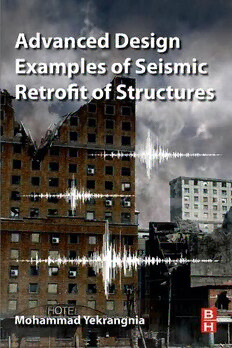Table Of ContentAdvanced Design Examples of Seismic
Retrofit of Structures
Advanced Design
Examples of Seismic
Retrofit of Structures
Mohammad Yekrangnia
Butterworth-HeinemannisanimprintofElsevier
TheBoulevard,LangfordLane,Kidlington,OxfordOX51GB,UnitedKingdom
50HampshireStreet,5thFloor,Cambridge,MA02139,UnitedStates
©2019ElsevierLtd.Allrightsreserved.
Nopartofthispublicationmaybereproducedortransmittedinanyformorbyanymeans,electronic
ormechanical,includingphotocopying,recording,oranyinformationstorageandretrievalsystem,
withoutpermissioninwritingfromthepublisher.Detailsonhowtoseekpermission,further
informationaboutthePublisher’spermissionspoliciesandourarrangementswithorganizations
suchastheCopyrightClearanceCenterandtheCopyrightLicensingAgency,canbefound
atourwebsite:www.elsevier.com/permissions.
Thisbookandtheindividualcontributionscontainedinitareprotectedundercopyrightbythe
Publisher(otherthanasmaybenotedherein).
Notices
Knowledgeandbestpracticeinthisfieldareconstantlychanging.Asnewresearchandexperience
broadenourunderstanding,changesinresearchmethods,professionalpractices,ormedical
treatmentmaybecomenecessary.
Practitionersandresearchersmustalwaysrelyontheirownexperienceandknowledgeinevaluating
andusinganyinformation,methods,compounds,orexperimentsdescribedherein.Inusing
suchinformationormethodstheyshouldbemindfuloftheirownsafetyandthesafetyofothers,
includingpartiesforwhomtheyhaveaprofessionalresponsibility.
Tothefullestextentofthelaw,neitherthePublishernortheauthors,contributors,oreditors,
assumeanyliabilityforanyinjuryand/ordamagetopersonsorpropertyasamatterofproducts
liability,negligenceorotherwise,orfromanyuseoroperationofanymethods,products,
instructions,orideascontainedinthematerialherein.
LibraryofCongressCataloging-in-PublicationData
AcatalogrecordforthisbookisavailablefromtheLibraryofCongress
BritishLibraryCataloguing-in-PublicationData
AcataloguerecordforthisbookisavailablefromtheBritishLibrary
ISBN:978-0-08-102534-5
ForinformationonallButterworth-Heinemannpublications
visitourwebsiteathttps://www.elsevier.com/books-and-journals
Publisher:MatthewDean
AcquisitionEditor:KenMcCombs
EditorialProjectManager:LeticiaLima
ProductionProjectManager:AnithaSivaraj
CoverDesigner:VictoriaPearson
TypesetbySPiGlobal,India
Contributors
Numbersinparenthesesindicatethepagesonwhichtheauthors’contributionsbegin.
SalarArian(1),InternationalInstituteofEarthquakeEngineeringandSeismology
(IIEES),Tehran,Iran
BehnamAzmoudeh(279),APSDesigningEnergy,Rome,Italy
AidaBejanli(119),SarzaminConsultingEngineers,Tehran,Iran
MortezaRaissiDehkordi(13,279),IranUniversityofScienceandTechnology,
Tehran,Iran
MahdiEghbali(279),DepartmentofCivilEngineering,FacultyofEngineering,
UniversityofZanjan,Zanjan,Iran
TeymourHonarbakhsh(119),SarzaminConsultingEngineers,Tehran,Iran
KamyarKarbasi(119),SarzaminConsultingEngineers,Tehran,Iran
ArashMardani(13),BureauofTechnicalandSupervision,DRES,Tehran,Iran
AbdorezaS.Moghadam(13,279),InternationalInstituteofEarthquakeEngineering
andSeismology(IIEES),Tehran,Iran
SamanehMohamadi(119),SarzaminConsultingEngineers,Tehran,Iran
KamranRahmati(119),DepartmentofReinforcementandMaintenanceofBridges
andTechnicalBuildingsofTehranMunicipality,Tehran,Iran
HamedSeyri(201),BureauofTechnicalandSupervision,DRES,Tehran,Iran
MohammadYekrangnia(1,13,201,391),DepartmentofCivilEngineering,Shahid
RajaeeTeacherTrainingUniversity,Tehran,Iran
xi
Preface
Earthquakevulnerabilityofbuildingshasbeenacknowledgedacrosstheglobe
with many examples of seismic damage in China, India, Latin America, and
Europe as well as the United States. Much attention has been focused on this
topic worldwide from both societal and engineering perspectives. As a result,
asignificantamountofdevelopmentworkhasbeencarriedouttoevaluatevar-
ious assessment methodologies and evaluate possible retrofit methods. The
main challenges in seismic retrofit are usually attributed to understanding the
availablecodesrequirements,modelingassumptions,methods,andretrofitting
schemes.
Seismic retrofit of structures covers a broad range of structural types and
retrofit methods, and hence it is more complex than designingnew buildings.
Itisquitelikelythattwoverydifferentretrofitmethodsmaybeproposedfora
singleprojectbytwodifferentconsultingengineers.Eventhedetailsofaunique
retrofittechniquemaydifferforasingleprojectbydifferentdesignengineers.
Partofthisvarietyoriginatesfromthedesignandimplementationambiguities
regarding retrofit projects. Compared to designing new buildings, retrofitting
has never been an undergraduate or graduate compulsory course; and there
are fewer retrofitting projects than there are new buildings being constructed.
As a result, experience in the design and implementation of retrofit projects
is very limited compared to ordinary construction projects. Although there
are good retrofit codes available to professionals, experiences prove that the
engineers’ “interpretations” of these codes may vary a lot. Therefore, there is
aneedtoelaboratetheconceptsofdesignandtheconstructiondetailsofretrofit
projects. In response to this need, the current book tries to present some real
projects that can be regarded as good representatives of different retrofit pro-
jectswiththeemphasisondealingwithambiguities,questions,anddifficulties
in design andconstruction.
Theideaforthisbookstartedsomeyearsagowithuniversitystudentsand
industrycolleagues,withthegoaloffacilitatingtheuseofdesigncodesrelated
to seismic retrofit of common structures. Beginning with the introduction of
conceptsandapproaches,thisbookaimsatpresentingseveralexamplesofreal
retrofittingprojectsthatcoverabroadrangeofstructuralsystemsandretrofit-
tingmethods.In-depthdesigncalculationproceduresarefoundineachexample
and the reason behind the selection of a particular method or assumption is
elaborated. The book not only provides a valuable source for previously
xiii
xiv Preface
implemented retrofit projects in design methods perspective but also supplies
severalphotosandconstructionaldetailsandproblemsregardingvariousretro-
fit projects. The book at times addresses the challenges in implementation of
someretrofittechniquesandproposessolutionstoeachofthedesignandcon-
struction challenges.
Thecontentandtreatmentofthesubjectsinthisbookareintendedtoappeal
to graduate-level students, teachers, and professional engineering community
members.Anaspectofthecurrentbookthatdistinguisheditfromprevioustexts
onseismicretrofitofstructuresisthatthisbookprovidesdetailedcalculations
and step-by-step guidelines for the retrofit of various types of structural sys-
tems. In some parts, this book also adopts a practical approach that focuses
onprovidingreaderswithseveralphotosofstructuraldamages,retrofitdetails,
andconstructionphasesoftheretrofitprojects.Themajorfeaturesofthisbook
thatmakeit uniqueare as follows.
– Thebookisexample-basedandhencefurtherhelpsreaderstoidentifyand
understand the problems regarding seismic retrofit of structures.
– It deals with real retrofitting projects in all the examples, and is full of
images and constructiondetails.
– Thebookcoversabroadrangeofstructuresfromnonengineeredhousesto
frame buildings.
– Itcontainsvariousretrofittingtechniquesthroughtheexamples,andinsome
cases their performance is compared.
Itisassumedthatreadershavegoodfamiliaritywiththebasicdesignconcepts
of steel, reinforced concrete, and unreinforced masonry buildings. Moreover,
preliminary knowledge of the concepts and approaches in seismic retrofit of
structures is required. Because the US design and seismic retrofit codes are
amongthemostwidespreaddesigncodesandtheirapproachandmethodologies
arewidelyadoptedbyothercodes,emphasishasbeenplacedonusingtheUS
codesinthisbook.Inaddition,theseismicdesigncodesofseveralcountriesare
moreorlesssimilartothecorrespondingUScodes,whichmakestheUScodes
oneof the best possiblechoices inthis regard.
Imustacknowledgethatthebookdoesnotcoverallthecommonstructural
systemsaroundtheworld;norhaveallthepossibleretrofittingmethodsforthe
examplebuildingsbeenevaluatedindetailinthechapters.Theselectionofthe
bestsolutionforthevulnerablebuildingsintheformoftheimplementedretrofit
methodsis subjectiveandhence,retrofitmethods otherthanthoseselected in
thisbookmayseemmoreappropriatetosomereaders.Iwouldbegratefulfor
anyconstructivecommentsorcriticismsthatreadersmayhaveandfornotifi-
cation of anyerrors thatthey may detect.
SpecialthanksgoestotheOrganizationforDevelopment,Renovationand
EquippingSchoolsofIRIran(DRES)fortheirsupportandcooperationinmy
usingsomeofitsmaterials.From2006to2016,vastundertakingsweremadeby
DRESintherealmofseismicriskreductionandimprovementofschoolsafety.
Preface xv
Forthestudyanddesignofseismicvulnerabilityandalsoconstructionofret-
rofit projects for nearly 130,000 classrooms in Iran, more than 100 private-
sectorconsultingcompanies,twosetsofnationalprojectmanagementsystems,
several elite university professors, and more than 400 contractors were
involved. Various common and innovative retrofit methods and procedures
were implemented in school buildings on the available structural systems
including unreinforced masonry (URM), steel, and reinforced concrete (RC)
framebuildings.Intotal,about $3billionwere dedicated andspent onrecon-
structionandretrofitprojectsbyDRES.Observationsfromrecentmajorearth-
quakesindicatethattheseismicperformanceoftheretrofittedschoolbuildings
wassatisfactoryandthesebuildingsmaintainedtheperformancelevelofimme-
diateoccupancy(IO),whereasmanyotherbuildingssustainedmajordamages
or experienced collapse. In recognition of these actions, the United Nations
SASAKAWAprizeforDisasterRiskReductionwasawardedtoDRESin2017.
Ihavebeenfortunatetobetaught,advised,andmentoredbyseveralextraor-
dinaryinstructorsandresearcherswithexpertiseinseismicretrofitofstructures.
Many individualshaveextended theirhelpinonewayoranotherintheprep-
arationofthisbook,andthesupportofsuchindividualsisgratefullyacknowl-
edged.Thanksareduetoallthecontributorsfortheircarefulpreparationofthe
contentsofthisbook.IamgratefultoDr.AliBakhshiandDr.MohammadAli
Ghannad,mysupervisorsduringmyMScandPhDfortheirmentorship.Iwould
alsoliketothankmyfriendMr.AlirezaMahdizadehforhisencouragementand
support.
Mohammad Yekrangnia
Chapter 1
Introduction
Mohammad Yekrangnia* and Salar Arian†
*DepartmentofCivilEngineering,ShahidRajaeeTeacherTrainingUniversity,Tehran,Iran,
†InternationalInstituteofEarthquakeEngineeringandSeismology(IIEES),Tehran,Iran
Aims
Byreadingthischapter,youareintroducedto:
l seismicriskreductionstrategies;
l performance-basedearthquakeengineering;
l basicterminologyinseismicretrofitstandards;and
l theconceptofseismicresilience.
1.1 INTRODUCTION
Because of the rich literature of earthquake engineering and decades of inter-
national efforts toward seismic risk characterization all around the world, the
major categories of possible losses from seismic damage are well classified.
Themostimportanttypeoflossesistheextentofcasualtieswhichledtointro-
ductionoftheprovisionoflifesafetyasthemainconcernofminimumtechnical
requirements incodes andstandardsaroundthe world.Thesecondsources of
concern are financial losses, either from direct costs of loss of or damage to
properties including the structures, infrastructures, and nonstructural compo-
nents, or due to loss of the function of the buildings and the recovery time
for the services provided by them.
Identification of all types of potential losses allows different stakeholders
such as individual owners of buildings and governments to compare their
importance against other demands for the use of limited resources for
budget allocation. Performance-based earthquake engineering, whether used
forriskassessmentandretrofitofexistingbuildingsordesignofnewones,pro-
videsa standard frameworkfor determination and measurement of losses [1].
Inthecaseofconstructionofnewbuildings,thebasicdesignproceduresas
wellastechnicaldetailstopreventdangerousfailuremodesarewellknownfor
mostengineeredstructuralsystemsaroundtheworld.Althoughbuildingcodes
are still constantly being updated, the challenges with new buildings are
AdvancedDesignExamplesofSeismicRetrofitofStructures.https://doi.org/10.1016/B978-0-08-102534-5.00001-5
©2019ElsevierLtd.Allrightsreserved. 1
2 AdvancedDesignExamplesofSeismicRetrofitofStructures
essentiallyabouttheeconomicandpoliticalpoliciestoimplementandenforce
design requirements.
However,oldbuildingsconstructedwithalmostnoseismicconsiderations
areconsideredtobethechiefsourceofseismicriskthreateningthemostcom-
munities. These buildings must beidentified and evaluatedto determine their
level of seismic risk, and then appropriate risk management solutions should
beselectedandimplementedforthem.Thischapterpresentstheoverallsteps
of procedures for risk assessment and retrofit of individual buildings as risk
assessment;readerscanfindmoredetailedinformationdescribingthesemeth-
odologieselsewhere [2].
Theseismicvulnerabilityevaluationoftheexistingbuildingscoversalmost
every aspect of earthquake engineering and construction techniques. On the
other hand, retrofit of individual buildings is the main part of the evaluation
and risk reduction strategies. It is worth noting that there are a variety of
research topics that will not be presented in detail here. In the next sections,
abrief review on these fields ofstudyis described.
1.2 SEISMIC RISK REDUCTION STRATEGIES
Seismiccodesandstandardstraditionallyhavenotbeendevelopedonthebasis
ofreliabilitymethodssuchasloadandresistancefactordesign(LRFD),because
ofthelackofavarietyofunknownparametersthatmusthavebeendefinedina
reliablemannerinthisdesignmethodology.Theneedtoknowtheprobabilityof
failureofcode-compatiblebuildingshasbeenrecognizedsincetheprovisionof
the associated commentary of ATC 3-06 [3]. Efforts through quantifying the
mentioned problem has been made by the SAC Steel Project [4]. To propose
aperformance-basedframeworkforthedesignofsteelmomentframes,thefirst
methodologywasdevelopedtoestimatetheprobabilityofcollapseofabuilding
underexcitationbydifferentgroundmotions[5].Theproposedapproachtried
to alleviate the variation in maximum demands of structures under scaled-to-
same-level time histories as well as other sources of uncertainties. Although
themethodfocusesonthequantificationofthecollapseasatargetperformance
level, the framework provided a basis that could be extended to other perfor-
mance targets. In the 1967 edition of the Blue Book [3], a clear performance-
related set of criteria were defined for buildings designed to its provisions:
(1) resist minor earthquakes without damage; (2) resist moderate earthquakes
withoutstructuraldamage,butwithsomenon-structuraldamage;and(3)resist
major earthquakes, of the intensity ofseverity ofthe strongestexperienced in
California,without collapse,butwith somestructuralaswellasnonstructural
damage.
Analysisofresponsesofthevastmajorityofbuildingsfortheeffectofseis-
micgroundmotionrequiresconsiderationofnonlinearstructuralbehavior[3].
It is not economically efficient to keep structural systems in the elastic range
understrongearthquakes,anditshouldbeborneinmindthatanelasticsuper-
structure response wouldseverelyincreasedisplacementdemands. Therefore,

